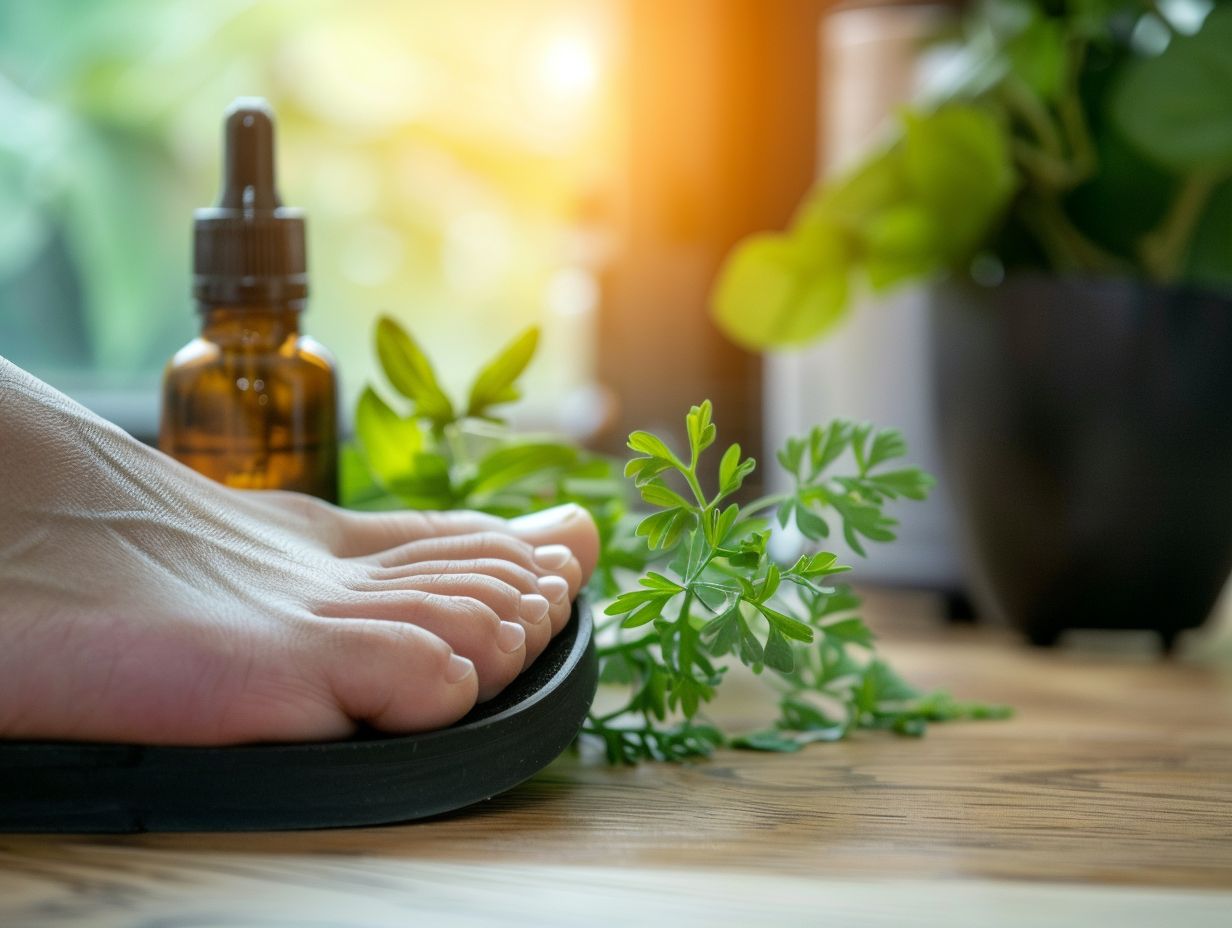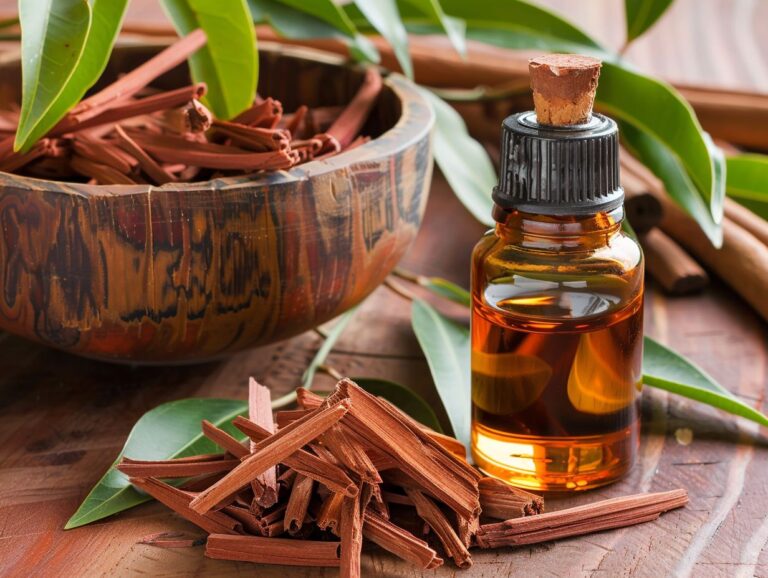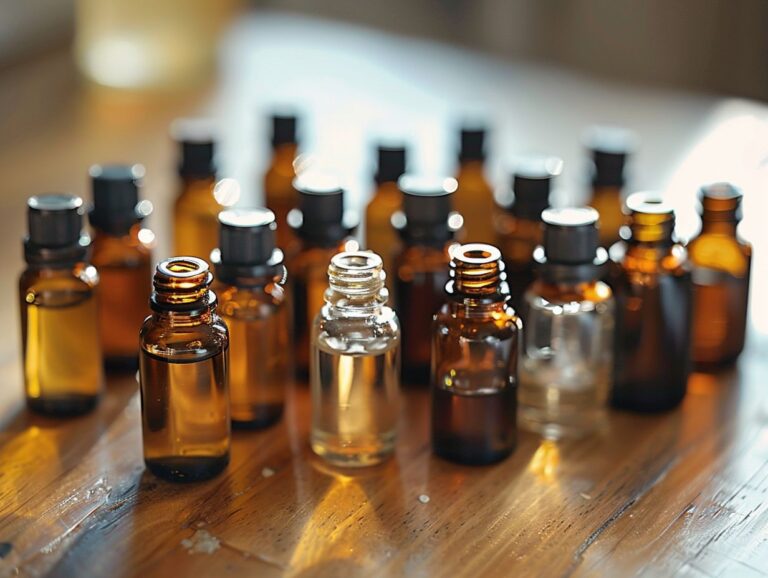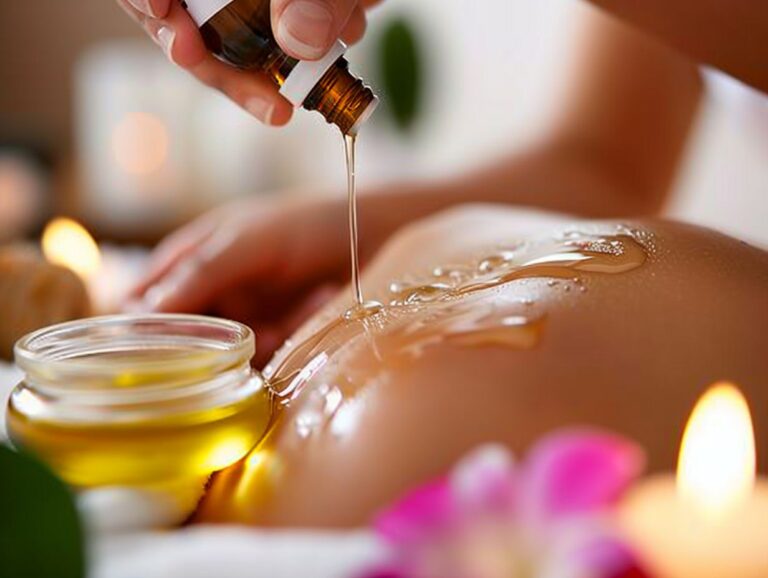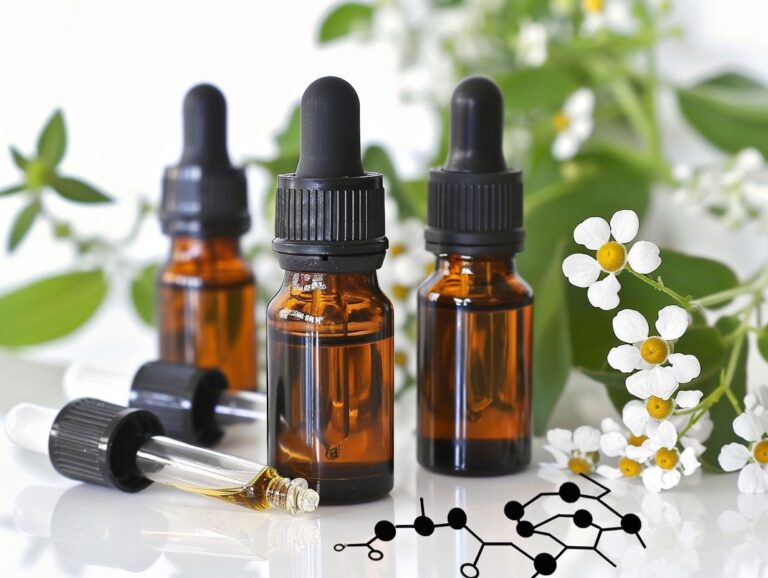Can Essential Oils Get Rid of Plantar Warts
Plantar warts can be a painful and stubborn nuisance, but have you ever considered using essential oils as a natural remedy?
We will explore the world of essential oils and their potential benefits in treating plantar warts.
From understanding what plantar warts are and what causes them, to discussing different treatment options including over-the-counter remedies, cryotherapy, laser treatment, and surgical removal, we will also delve into the effectiveness of essential oils such as tea tree oil, oregano oil, lemon oil, and eucalyptus oil.
Learn how to use essential oils for plantar warts, potential risks and side effects, and when it’s time to seek professional medical help.
Let’s dive in and discover the power of essential oils in treating plantar warts.
Key Takeaways:
What Are Essential Oils?
Essential oils are natural compounds extracted from plants that capture the plant’s scent and flavor, also known as its ‘essence.’ These oils are commonly used in aromatherapy, skincare, and natural health remedies.
Extraction of essential oils involves various methods such as distillation, cold pressing, or solvent extraction, ensuring the concentrated form of the plant’s beneficial compounds. Quality and purity are crucial factors as they directly impact the efficacy of the oils.
These oils offer a range of benefits, including relaxation, stress relief, and skin rejuvenation. In aromatherapy, essential oils are diffused to promote emotional well-being, while in skincare, they are used for their anti-inflammatory and antibacterial properties. Essential oils are popular in holistic healing practices, aiding in treating various ailments naturally.
What Are Plantar Warts?
Plantar warts are noncancerous skin growths that appear on the soles of the feet, often causing discomfort and pain when walking or standing. These warts are caused by the human papillomavirus (HPV) and are usually characterized by their rough, grainy texture.
These warts may have small black dots, which are actually clotted blood vessels, giving them a speckled appearance. Typically, plantar warts develop on weight-bearing areas like the heels or balls of the feet. Common symptoms include tenderness, pain with pressure, and a thickened area of skin that may have a callus-like appearance. If left untreated, plantar warts can grow larger, multiply, or spread to other parts of the foot. In some cases, they can cause difficulty walking or standing for long periods.
Treating plantar warts may involve over-the-counter salicylic acid treatments to remove the outer layers of the skin affected by the wart. Cryotherapy, which freezes the wart off, or laser therapy may be used for more stubborn warts. It’s essential to note that self-treatment can sometimes worsen the condition or lead to infection.
What Causes Plantar Warts?
Plantar warts are caused by the human papillomavirus (HPV), specifically strains that thrive in warm and moist environments, such as swimming pool areas or communal showers. The virus enters the body through tiny cuts or breaks in the skin, leading to the formation of warts.
HPV is highly contagious and can be transmitted through direct skin-to-skin contact with an infected person or by touching surfaces contaminated with the virus. Factors like walking barefoot in public spaces, sharing towels or shoes, and having a weakened immune system can increase the risk of contracting HPV.
To prevent plantar warts, it is crucial to maintain good foot hygiene, wear protective footwear in public areas, and avoid contact with suspected contaminated surfaces. Regularly cleaning and drying feet thoroughly, especially after swimming or using communal showers, can significantly reduce the likelihood of developing these uncomfortable growths.
Who Is Most At Risk For Plantar Warts?
Individuals with weakened immune systems, children, and those with pre-existing skin conditions are at a higher risk of developing plantar warts due to their susceptibility to viral infections and skin damage.
People with compromised immune responses, such as those undergoing chemotherapy or with autoimmune disorders, are particularly vulnerable to plantar warts as their bodies struggle to combat the HPV virus effectively. Children with less developed immune systems and thinner skin layers are more prone to contracting these warts through cuts or abrasions on the feet. Older adults, especially over the age of 60, may experience a natural decline in immune function, making them susceptible to plantar wart formation.
To reduce the risk of plantar warts, individuals in these high-risk groups should pay extra attention to foot hygiene, wear protective footwear in communal areas, and avoid walking barefoot in damp environments where the virus thrives. Regularly inspecting the feet for any signs of warts or skin damage and seeking prompt medical attention can also aid in early detection and management of plantar warts for these vulnerable populations.
How Are Plantar Warts Diagnosed?
Plantar warts are typically diagnosed through a visual examination by a healthcare professional, who may also perform additional tests such as a skin biopsy to confirm the presence of the warts and rule out other skin conditions.
During the visual examination, healthcare providers look for characteristic signs like small, grainy growths on the soles of the feet with tiny black dots representing clotted blood vessels. In some cases, a dermatoscope might be used to inspect the wart closely.
If there is uncertainty in the diagnosis, a skin biopsy may be recommended. This involves taking a small sample of the wart tissue for microscopic examination. Medical professionals play a crucial role in not only identifying but also distinguishing plantar warts from other skin lesions.
What Are The Treatment Options For Plantar Warts?

When considering over-the-counter options, salicylic acid patches are commonly used to gradually remove plantar warts. These patches work by softening the skin and breaking down the wart tissue.
For more aggressive treatments, cryotherapy involves freezing the wart with liquid nitrogen, causing it to eventually fall off. While effective, this method can be mildly painful and may require multiple sessions for complete removal.
Laser treatment, on the other hand, uses focused light energy to destroy the wart tissue. Although more expensive, this approach is often quicker and has fewer side effects compared to surgical options.
Over-The-Counter Treatments
Over-the-counter treatments for plantar warts include topical solutions, medicated pads, and patches that aim to dissolve the wart tissue gradually. These treatments are convenient for home use and can be effective for mild cases of warts.
One of the popular topical solutions available is salicylic acid, which works by breaking down the layers of the wart over time. It is recommended to apply the solution directly onto the wart after soaking the foot in warm water to soften the skin. Medicated pads containing salicylic acid are also commonly used as they provide a controlled dose of the active ingredient.
There are patches infused with ingredients like duct tape or other chemicals that create an environment to suffocate the wart. These patches need to be changed regularly to maintain the treatment efficacy.
Consistency in applying these treatments is key to achieving the desired results. It is essential to follow the instructions carefully and continue the regimen until the wart completely disappears. Inconsistent treatment can lead to recurrence or prolong the healing process. By diligently adhering to the treatment plan, individuals can expect gradual improvement and eventual elimination of the plantar wart.
Cryotherapy
Cryotherapy is a medical procedure that involves freezing the plantar wart using liquid nitrogen to destroy the affected tissue. This treatment is performed by healthcare professionals and may require multiple sessions for complete wart removal.
Cryotherapy is a highly precise method that targets the wart directly, delivering controlled freezing temperatures to remove it effectively. The freezing action causes the wart to eventually fall off, with the surrounding healthy tissue remaining unharmed. After the treatment, it’s essential to follow proper post-treatment care instructions to aid in healing and prevent infection. Potential side effects of cryotherapy may include temporary blistering, redness, or discomfort, but these usually subside within a few days.
Laser Treatment
Laser treatment for plantar warts involves targeting the wart tissue with concentrated light energy to destroy the infected cells. This procedure is typically performed by dermatologists and offers a precise and minimally invasive approach to wart removal.
Laser treatment works by delivering intense beams of light directly onto the wart, effectively vaporizing the abnormal tissue while leaving surrounding healthy skin unharmed. This targeted approach significantly reduces the risk of collateral damage, making it a safe and efficient solution for patients seeking wart removal.
Post-laser therapy, patients may experience mild discomfort or redness at the treatment site, which typically resolves within a few days. Successful treatment often results in complete wart regression, with minimal scarring or recurrence of the warts.
Surgical Removal
Surgical removal of plantar warts involves excising the wart tissue under local anesthesia to ensure complete eradication. This procedure is reserved for persistent or large warts that do not respond to other treatment modalities.
Pre-operative assessments are crucial before undergoing surgical removal of plantar warts. This typically includes a thorough evaluation of the patient’s medical history, current medications, and any underlying health conditions that may affect the surgery. The surgeon may request blood tests to ensure the patient is fit for the procedure.
Regarding surgical techniques for removing plantar warts, the most common approach is excision, where the wart tissue is cut out using a scalpel or laser. This method aims to completely remove the wart along with any surrounding infected tissue to prevent recurrence.
After the surgery, post-operative care requirements are essential for proper healing. This involves keeping the surgical area clean and dry, following the surgeon’s instructions for dressing changes, and taking prescribed medications to prevent infection and promote healing.
Despite its effectiveness, surgical removal of plantar warts carries potential risks, such as infection, scarring, and nerve damage. The benefits of complete wart removal, especially for persistent warts, often outweigh these risks, leading to successful treatment outcomes.
Can Essential Oils Help Get Rid Of Plantar Warts?
Essential oils like tea tree oil, oregano oil, lemon oil, and eucalyptus oil are known for their antiviral properties and are often used as natural remedies to aid in the removal of plantar warts. These oils can be effective in combating the HPV virus and promoting wart healing.
When using essential oils for plantar wart treatment, it is important to dilute them with a carrier oil to avoid skin irritation, especially for individuals with sensitive skin.
Tea tree oil is particularly popular due to its potent antiviral and anti-inflammatory properties that can help reduce the size and discomfort of warts.
Oregano oil is another powerful option known for its antimicrobial properties that can target and eliminate the virus responsible for the wart’s growth.
Applying lemon oil can be beneficial as it acts as a natural exfoliant, aiding in the removal of dead skin cells around the wart.
Tea Tree Oil

When using tea tree oil for plantar warts, it is crucial to dilute it properly to avoid skin irritation. A recommended dilution ratio is 1 part tea tree oil to 3 parts carrier oil, such as coconut or olive oil.
One effective method is to apply the diluted oil directly to the wart using a cotton swab, covering it with a bandage to enhance absorption.
It is important to be consistent with the application, typically twice a day, for best results. Some individuals may experience mild skin irritation or allergic reactions, so a patch test is advised before widespread use.
Oregano Oil
Oregano oil contains powerful antiviral compounds that can target the HPV virus responsible for plantar warts. When applied topically, oregano oil may help reduce wart size and promote faster healing.
One of the key components in oregano oil is carvacrol, which has been shown to exhibit strong antiviral activity.
When oregano oil comes into contact with the virus-infected skin, it can penetrate the wart tissue and hinder the replication of the HPV virus. This action helps in breaking down the wart and stimulating the body’s immune response to clear the infection.
For safe usage, diluting oregano oil with a carrier oil like coconut or olive oil is recommended to prevent skin irritation.
Application techniques involve using a cotton swab to apply the diluted oregano oil directly onto the wart, ensuring to cover the entire affected area without spreading to surrounding healthy skin.
Lemon Oil
Lemon oil is rich in antiviral components that can target the HPV virus and support the healing of plantar warts. The refreshing scent of lemon oil also provides a pleasant experience during treatment.
The antiviral properties of lemon oil make it an effective natural remedy for plantar warts. When applied topically, the oil helps inhibit the replication of the HPV virus, reducing the size and appearance of warts over time. Lemon oil’s aromatic benefits can uplift mood and create a calming atmosphere during wart treatment.
It is important to dilute lemon oil with a carrier oil before applying it to the skin to prevent any potential irritation. A safe dilution ratio is typically 2-5% lemon oil to carrier oil. Always perform a patch test before widespread application to ensure no adverse reactions occur.
Eucalyptus Oil
Eucalyptus oil is known for its antiviral and anti-inflammatory properties, making it a valuable natural remedy for plantar warts. The oil’s cooling effect can also help alleviate discomfort associated with wart growth.
When using eucalyptus oil for treating plantar warts, it is recommended to dilute it with a carrier oil like coconut or almond oil. This helps to prevent skin irritation and sensitivities, ensuring a safe application.
Eucalyptus oil can be applied topically directly to the wart using a cotton ball or swab. Its antiviral properties target the virus causing the wart, while the anti-inflammatory nature helps reduce swelling and redness.
For enhanced efficacy, consider combining eucalyptus oil with tea tree oil, known for its antimicrobial properties, creating a powerful blend to combat warts.
It is important to perform a patch test before using eucalyptus oil extensively to check for any adverse reactions. If sensitivity occurs, discontinue use immediately.
How To Use Essential Oils For Plantar Warts?
When using essential oils for plantar warts, it’s essential to dilute the concentrated oils with a carrier oil like coconut oil to prevent skin irritation. Apply the diluted essential oil directly to the wart using a clean cotton ball or swab for targeted treatment.
It’s important to remember that essential oils are highly concentrated substances and can cause adverse reactions if not properly diluted. To create a safe and effective blend, mix 2-3 drops of the essential oil with a tablespoon of carrier oil. This will help reduce the risk of skin sensitivities and ensure that the treatment is gentle yet potent.
Consistency is key when treating plantar warts with essential oils. Apply the diluted mixture to the wart twice a day, once in the morning and once at night. Cover the treated area with a bandage to enhance absorption and protect the skin.
It’s advisable to perform a patch test before widespread application. Apply a small amount of the diluted oil mixture to a discreet area of skin, such as the inner forearm, and wait 24 hours to check for any adverse reactions. This simple step can help identify potential allergies or sensitivities.
Are There Any Risks Or Side Effects Of Using Essential Oils For Plantar Warts?
While essential oils are generally safe when used correctly, there are potential risks and side effects to consider when treating plantar warts. Skin irritation, allergic reactions, and sensitivities may occur, especially if the oils are not properly diluted or applied.
It is crucial to conduct a patch test before using essential oils directly on the skin. This involves applying a small amount of diluted oil to a small area of healthy skin and monitoring for any adverse reactions over 24 hours. Any signs of redness, itching, or irritation should raise concerns and prompt discontinuation of the oil.
For proper dilution, it is recommended to mix essential oils with carrier oils like coconut or olive oil in a ratio of 2-3 drops per teaspoon of carrier oil. Monitoring the skin for any changes during treatment is vital to prevent complications.
When Should You See A Doctor For Plantar Warts?

It is advisable to consult a healthcare professional if plantar warts persist, multiply, or cause severe pain and discomfort.
This is especially important as medical intervention may be necessary for stubborn warts that do not respond to home remedies or over-the-counter treatments. Infection of plantar warts can lead to redness, swelling, or pus formation, indicating a need for medical attention.
If the pain associated with plantar warts increases significantly, or if there is a sudden rapid growth in size or number of warts, seeking professional care is crucial. Healthcare providers can accurately diagnose the condition, assess the severity, and offer personalized treatment plans to effectively manage and eradicate the plantar warts.
Frequently Asked Questions
Can Essential Oils Get Rid of Plantar Warts?
Yes, essential oils have been found to be effective in treating plantar warts.
What are essential oils?
Essential oils are concentrated plant extracts that are used in aromatherapy and natural remedies.
Which essential oils are best for treating plantar warts?
Tea tree oil, oregano oil, and lemon oil are some of the most effective essential oils for getting rid of plantar warts.
How do I use essential oils to treat plantar warts?
Essential oils can be applied directly to the wart using a cotton swab or mixed with a carrier oil and massaged into the affected area.
Are there any side effects of using essential oils for plantar warts?
Most essential oils are safe to use, but it is important to dilute them properly and do a patch test first to avoid any potential skin irritation.
Can essential oils be used as a standalone treatment for plantar warts?
While essential oils may be effective in getting rid of plantar warts, it is best to consult a healthcare professional for proper diagnosis and treatment. Essential oils can be used as a complementary therapy alongside medical treatments.

